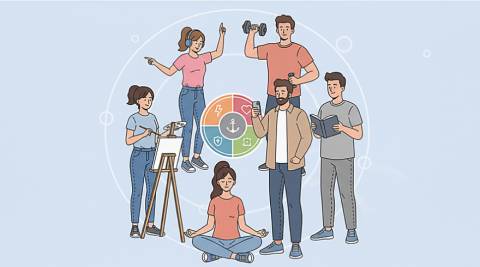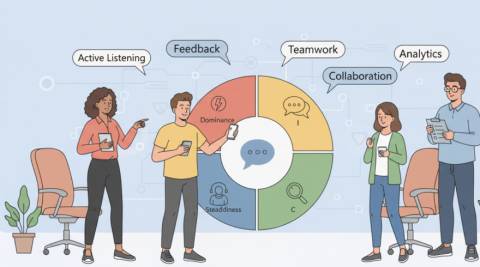Mastering Communication Style Profiling for Real-World Results

Understanding Communication Styles in Context
Every conversation blends message, tone, timing, and intention into a distinctive pattern that others experience as a “style.” These patterns show up in meetings, emails, negotiations, and feedback sessions, shaping trust and momentum in ways we often underestimate. When people recognize how they naturally express ideas and interpret signals, they can adapt with purpose instead of reacting on autopilot. That awareness improves alignment under pressure and enables more persuasive storytelling across functions and cultures.
Beyond labels or quick typologies, organizations benefit when they translate style insights into day-to-day behaviors and shared norms. Within many enterprises, communication assessment outputs become a practical vocabulary for building psychological safety and reducing friction. Teams learn how to ask for clarity, how to calibrate tone, and how to select the right medium for the moment. As a result, collaboration accelerates because ambiguity shrinks and intent becomes easier to read.
Clarity also grows when individuals observe their patterns across different settings, from one-on-ones to all-hands. In that reflective process, self assessment of communication can reveal contextual shifts that either help or hinder effectiveness. People often discover that stress amplifies certain signals, such as speed or directness, in ways that others may misinterpret. Equipped with those insights, professionals can build adaptive range without losing their authentic voice.
Benefits That Compound for Individuals, Teams, and Organizations
High-performing cultures rarely treat interpersonal dynamics as an afterthought, because they understand how misalignment drains time and energy. When style awareness is common, meetings tighten up, decisions move faster, and cross-functional work becomes less fraught. Leaders get clearer on how to frame trade-offs, and contributors feel safer speaking candidly about risks. The payoff shows up in engagement, retention, and customer outcomes.
For leaders under constant time pressure, a targeted diagnostic can surface blind spots before they harden into habits. In many leadership programs, a communication style assessment provides a shared reference point for coaching conversations and growth plans. That shared lens reduces the tendency to pathologize differences and instead turns them into complementary strengths.
- Sharper self-awareness that turns instinctive reactions into intentional choices
- Reduced misunderstandings through clearer expectations and role-aligned behaviors
- Faster conflict resolution by naming patterns rather than assigning blame
- More inclusive collaboration by honoring diverse preferences and processing speeds
- Better customer and stakeholder experiences through tailored messaging
When teams normalize style dialogue, they can codify norms that stick under real-world constraints. Across departments and geographies, a communication styles assessment often reduces friction by creating shared language that scales. That same language helps new hires ramp more quickly because expectations are explicit rather than implicit. Over time, the culture becomes more resilient and adaptable.
Frameworks, Models, and Data You Can Trust
Not all models are created equal, and it pays to choose approaches backed by solid constructs, transparent scoring, and clear use cases. Some methods emphasize observable behaviors, while others focus on preferences, needs, or values that drive communication choices. Strength lies in using a framework as a conversation starter rather than a box that limits growth. The best programs combine rigor, practicality, and ethical safeguards around privacy and bias.
Many teams start with a behaviorally anchored model that translates easily to day-to-day interactions. In fast-moving environments, the DISC assessment communication styles framework can help participants grasp differences quickly without heavy jargon. That quick uptake encourages immediate experimentation with new tactics in meetings, emails, and feedback loops.
| Approach | What It Reveals | Best For | Watch Outs |
|---|---|---|---|
| DISC | Behavioral tendencies and interaction pace | Sales, service, cross-functional collaboration | Avoid stereotyping or overgeneralizing styles |
| Social Styles | Assertiveness and responsiveness patterns | Negotiations and stakeholder management | Context can shift observed behaviors |
| MBTI-informed Methods | Preference-driven information flow | Team charters and reflective development | Use responsibly and avoid selection misuse |
| Big Five–based Tools | Trait-informed communication predictors | Research-literate programs and validation needs | Requires careful interpretation training |
| 360 Feedback | Observable impact across audiences | Leadership development and culture change | Safeguard anonymity and feedback quality |
Whether you choose behavioral, preference, or multi-rater inputs, the infrastructure around the work matters as much as the instrument. When scale and consistency are critical, a communication styles assessment tool with reporting, norms, and integrations supports enterprise adoption. Robust administration also ensures equitable access, repeatability, and data governance that leaders can trust.
Some situations call for higher psychometric rigor, such as regulated industries or research-backed leadership programs. Where defensibility is paramount, a communication assessment test offers reliability evidence, benchmarking, and decision audit trails. Pairing that rigor with pragmatic facilitation keeps the insights usable rather than abstract.
How to Run an Assessment and Interpret Results Responsibly
Effective implementations start well before anyone clicks a link, because purpose and expectations set the tone for everything that follows. Clarify what success looks like, who will see results, and how insights translate into behavior change. Get leadership sponsorship so time is protected for debriefs and practice. Finally, plan follow-through so the work doesn’t fade after the initial excitement.
- Define objectives such as feedback quality, meeting efficiency, or onboarding speed
- Select the model and delivery method that fit your culture and constraints
- Communicate privacy, timelines, and support resources to participants
- Schedule group debriefs and role-relevant practice sessions
- Measure behavior changes and business outcomes over time
Interpretation should connect dots between patterns, contexts, and practical choices that people can try immediately. For quick entry points or pilots, a free online communication style assessment can ignite curiosity while you design a deeper program. The key is turning insights into experiments so people feel progress quickly.
Coaches and managers can reinforce growth by asking for specific examples, not generalities, during one-on-ones and retrospectives. Between formal initiatives, a communication self assessment helps individuals track signals like pacing, questions asked, and tone under stress. These micro-checkpoints build momentum without adding heavy process overhead.
Applying Insights to Everyday Workflows
Insights become transformative when they shape rituals people already practice, such as standups, demos, and pipeline reviews. Teams can create lightweight norms that nudge better habits, like ending meetings with a clarity check or naming the communication goal upfront. Sales and success roles can tailor discovery questions to match stakeholder pacing and preference. Product and engineering can improve handoffs by flagging assumptions and framing trade-offs succinctly.
For personal development, journaling observations after key interactions accelerates learning curves and confidence. In this reflective loop, a communication styles self assessment can spotlight triggers, strengths, and growth edges that might otherwise stay invisible. Over weeks, small adjustments compound into noticeable credibility and rapport.
- Draft emails with explicit purpose, ask, and next step in the first lines
- Match medium to message by using async for updates and live time for decisions
- Vary pace and detail based on audience preferences and stakes
- Invite summaries from others to confirm shared understanding
- Practice “intent, observation, impact” when giving feedback
Accessibility matters too, because equitable tools broaden participation and learning. To lower barriers for pilots or community programs, a communication style assessment free tier can seed adoption while demonstrating value. As momentum builds, leaders can invest in deeper analytics and coaching resources that sustain change.
FAQ: Common Questions About Communication Style Evaluation
How accurate are style results in real-world settings?
Accuracy depends on model quality, honest participation, and context-aware interpretation by skilled facilitators. Over time, patterns that feel “mostly true” become more precise as people practice and compare notes across different scenarios.
Can small teams benefit without a large budget?
Lean teams can start with targeted rituals, lightweight debriefs, and practical norms that cost little but deliver compounding benefits. If budget is tight, a communication styles self assessment exercise offers a simple on-ramp to reflection and shared vocabulary.
Will people feel labeled or boxed in by a framework?
Framing matters, so position styles as starting points for dialogue rather than fixed identities. Emphasize adaptability, context, and choice so participants experience the work as empowering rather than limiting.
How should we handle privacy and data ethics?
Share clear policies on data access, storage, and reporting before any rollout begins. Keep ownership with the participant whenever possible, and aggregate trends for managers to avoid singling out individuals.
What is the ideal cadence for follow-up?
Plan a short debrief soon after results, then reinforce insights in existing meetings for at least two cycles. Revisit commitments quarterly to evolve norms as teams, projects, and stakeholders change.
Latest News



